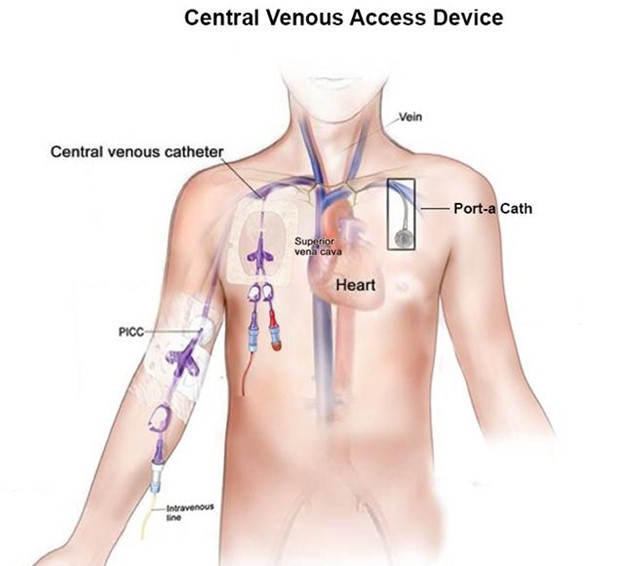Types of IV Access
- There are two main types of IV access: peripheral and central.
Peripheral IV Access
- Peripheral IV access involves inserting a catheter into a vein in the hand or arm.
- Peripheral IV access is suitable for short-term therapy (less than a week) and low-risk fluids or medications.
- Peripheral IV access may also be used for specialized placement in the external jugular vein or the dorsal foot vein.
- Peripheral IV access requires a tourniquet to constrict the vein and make it more visible and palpable.
- Peripheral IV access uses angiocatheters that range from 14 to 24 gauge in size. The gauge refers to the diameter of the catheter; the larger the gauge, the smaller the diameter. The choice of gauge depends on the type and viscosity of the fluid or medication, the size and condition of the vein, and the duration of therapy.
- Peripheral IV access may cause complications such as infiltration, phlebitis, infection, hematoma, nerve damage, or extravasation.
Central IV Access

- Central IV access involves inserting a catheter into a large vein that leads directly to the heart.
- Central IV access is suitable for long-term therapy (more than a week) and high-risk fluids or medications that require rapid dilution or precise infusion rates.
- Central IV access may be achieved through percutaneous central lines, peripherally inserted central catheters (PICCs), tunneled catheters, or implanted ports.
- Central IV access does not require a tourniquet but may require ultrasound guidance or fluoroscopy to locate the vein and confirm placement.
- Central IV access uses catheters that range from 16 to 24 gauge in size. The choice of gauge depends on the type and volume of fluid or medication, the number of lumens (channels) needed, and the patient’s condition.
- Central IV access may cause complications such as pneumothorax, hemothorax, air embolism, infection, thrombosis, or catheter malposition.
Nursing Test Bank
Quiz #1: RN Exams Pharmacology Exams
Quiz #2: RN Exams Medical-Surgical Exams
Quiz #3: RN Exams Fundamentals Exams
Quiz #4: RN Exams Maternal-Newborn Exams
Quiz #5: RN Exams Anatomy and Physiology Exams
Quiz #6: RN Exams Obstetrics and Pediatrics Exams
Quiz #7: RN Exams Fluid and Electrolytes Exams
Quiz #8: RN Exams Community Health Exams
Quiz #9: RN Exams Promoting Health across the lifespan Exams
Quiz #10: RN Exams Multidimensional care Exams
Naxlex Comprehensive Predictor Exams
Quiz #1: Naxlex RN Comprehensive online practice 2019 B with NGN
Quiz #2: Naxlex RN Comprehensive Predictor 2023
Quiz #3: Naxlex RN Comprehensive Predictor 2023 Exit Exam A
Quiz #4: Naxlex HESI Exit LPN Exam
Quiz #5: Naxlex PN Comprehensive Predictor PN 2020
Quiz #6: Naxlex VATI PN Comprehensive Predictor 2020
Quiz #8: Naxlex PN Comprehensive Predictor 2023 - Exam 1
Quiz #10: Naxlex HESI PN Exit exam
Quiz #11: Naxlex HESI PN EXIT Exam 2
Questions on Types of IV Access
Search Here
Related Topics
More on Nursing
Free Nursing Study Materials
Access to all study guides and practice questions for nursing for free.
- Free Nursing Study Trials
- Free Nursing Video tutorials
- Free Nursing Practice Tests
- Free Exam and Study Modes
- Free Nursing Revision Quizlets
